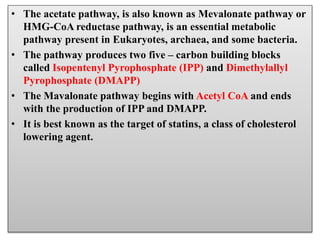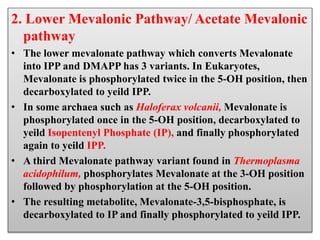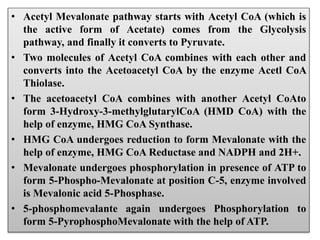Acetate acid pathway
- 1. Acetate Pathway Presented by Sonali S Gadge Lecturer P R Patil Institute of Pharmacy, Talegaon (SP), Dist-Wardha.
- 2. âĒ The acetate pathway, is also known as Mevalonate pathway or HMG-CoA reductase pathway, is an essential metabolic pathway present in Eukaryotes, archaea, and some bacteria. âĒ The pathway produces two five â carbon building blocks called Isopentenyl Pyrophosphate (IPP) and Dimethylallyl Pyrophosphate (DMAPP) âĒ The Mavalonate pathway begins with Acetyl CoA and ends with the production of IPP and DMAPP. âĒ It is best known as the target of statins, a class of cholesterol lowering agent.
- 3. Types of Mevalonate Pathway 1. Upper Mevalonate Pathway/Acetate Mevalonate Pathway âĒ The Mevalonate pathway of Eukaryotes archaea and bacteria all begin the same way. âĒ The sole carbon feed stock of the pathway is Acetyl CoA. The first step condenses two Acetyl CoA molecules to yeild Acetoacetyl CoA. This followed by a second condensation to form HMG-CoA (3-Hydroxy-3-Methyl-glutaryl-CoA). âĒ Reduction of HMG-CoA yeilds Mevalonate. These first three Enzymatic steps are called the upper Mevalonic pathway.
- 4. 2. Lower Mevalonic Pathway/ Acetate Mevalonic pathway âĒ The lower mevalonate pathway which converts Mevalonate into IPP and DMAPP has 3 variants. In Eukaryotes, Mevalonate is phosphorylated twice in the 5-OH position, then decarboxylated to yeild IPP. âĒ In some archaea such as Haloferax volcanii, Mevalonate is phosphorylated once in the 5-OH position, decarboxylated to yeild Isopentenyl Phosphate (IP), and finally phosphorylated again to yeild IPP. âĒ A third Mevalonate pathway variant found in Thermoplasma acidophilum, phosphorylates Mevalonate at the 3-OH position followed by phosphorylation at the 5-OH position. âĒ The resulting metabolite, Mevalonate-3,5-bisphosphate, is decarboxylated to IP and finally phosphorylated to yeild IPP.
- 8. âĒ Acetyl Mevalonate pathway starts with Acetyl CoA (which is the active form of Acetate) comes from the Glycolysis pathway, and finally it converts to Pyruvate. âĒ Two molecules of Acetyl CoA combines with each other and converts into the Acetoacetyl CoA by the enzyme Acetl CoA Thiolase. âĒ The acetoacetyl CoA combines with another Acetyl CoAto form 3-Hydroxy-3-methylglutarylCoA (HMD CoA) with the help of enzyme, HMG CoA Synthase. âĒ HMG CoA undergoes reduction to form Mevalonate with the help of enzyme, HMG CoA Reductase and NADPH and 2H+. âĒ Mevalonate undergoes phosphorylation in presence of ATP to form 5-Phospho-Mevalonate at position C-5, enzyme involved is Mevalonic acid 5-Phosphase. âĒ 5-phosphomevalante again undergoes Phosphorylation to form 5-PyrophosphoMevalonate with the help of ATP.
- 9. âĒ 5-Pyrophosphomevalonate is then converted to two important precursors i.e. Isopentenyl Pyrophosphate and Dimethylallyl Pyrophosphate which is responsible for the synthesis of different types of Isoprenoids with the help of enzyme 5- Pyroposphate decarboxylase. âĒ This Isopentenyl Pyrophosphate undergoes Isomerisation to form DimehtylallylPyrophosphate with the help of enzyme IPP Isomerase. âĒ Isopentyl Pyrophosphate and DimehtylallylPyrophosphate undergoes condensation to form Geramyl Pyrophosphate. âĒ Geranyl Pyrophosphate is further converted to Formesyl Pyrophosphate due to the addition of IPP, with the release of P2O6. âĒ To the Formesyl Pyrophosphate, IPP is added to form Geranyl Geranyl Pyrophosphate. âĒ To the Formesyl Pyrophosphate, FPP is added to form Squalene.









